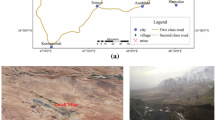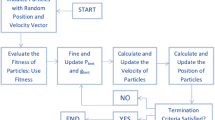Abstract
This paper explores the applicability of rapidly growing machine learning techniques (MLTs) for predicting the vibration response of geocell reinforced soil beds. Peak particle velocity (PPV) is used as an indicator to represent the vibration response. Two machine learning techniques namely, Genetic programming (GP), and multivariate adaptive regression splines (MARS) are used for the PPV prediction. Primarily, a series of field vibration tests were conducted over the geocell reinforced beds to obtain the dataset for model development. During the field test, PPV variation was studied by varying the test parameters namely, footing embedment, dynamic load, modulus of infill material, width, and depth of placement of geocell mattress. In total, 240 field measurements were used to formulate the PPV prediction models. The prediction performance of a developed model was examined by determining the different statistical indices. In addition, the ranking of each input parameter was calculated to identify the parameter, which influences the PPV most. According to the outcome of developed models, coefficient of determination (R2) values of (0.9918, 0.9852), and (0.9949, 0.9941), were observed for training and testing data sets of GP and MARS models, respectively. The sensitivity analysis of both the models revealed that the distance from the source to the measurement point indicating the damping properties of the reinforced bed is predominantly affecting PPV. Further, a comparative study has been carried out to examine the efficiency of the developed model in predicting the PPV response at the unknown dynamic excitation. The results of the comparative analysis revealed that the MARS model exhibits a high degree of accuracy in predicting the PPV variation in comparison to GP.














Similar content being viewed by others
References
American Association of State Highway and Transportation Officials (AASHTO) (1990) Standard Recommended Practice for Evaluation of Transportation-related Earth borne Vibrations. Washington, DC
Standard B (1993) BS7385-2 Evaluation and measurement for vibration in buildings. In: Guide to damage levels from groundborne vibration
Dhar BB, Pal RP, Singh RB (1993) Optimum blasting for Indian geo-mining conditions suggestive standard and guidelines. CMRI Publication, India
Building and Civil Engineering Standards Committee (1999) DIN4150-3 structural vibration part 3: effects of vibration on structures. DIN Germany Institute, Germany
Directorate General of Mines & Safety (DGMS, India) (1997) Technical Circular 7 of 1997, India, p 6
Standard S (1978) SN 640 312: effects of vibration of construction. In: Swiss Association of Standarization, Zurich
Johnson AP, Hannen WR (2015) Vibration limits for historic buildings and art collections. APT Bull J Preserv Technol 46(2/3):66–74
Singh PK, Roy MP (2010) Damage to surface structures due to blast vibration. Int J Rock Mech Min Sci 47(6):949–961
Tafreshi SM, Zarei SE, Soltanpour Y (2008) Cyclic loading on foundation to evaluate the coefficient of elastic uniform compression of sand. In: The 14th world conference on earthquake engineering, Beijing, China
Hegde A, Sitharam TG (2016) Behaviour of geocell reinforced soft clay bed subjected to incremental cyclic loading. Geomech Eng 10(4):405–422
Hegde A (2017) Geocell reinforced foundation beds-past findings, present trends and future prospects: a state-of-the-art review. Constr Build Mater 154:658–674
Venkateswarlu H, Ujjawal KN, Hegde A (2018) Laboratory and numerical investigation of machine foundations reinforced with geogrids and geocells. Geotext Geomembr 46(6):882–896
Ujjawal KN, Venkateswarlu H, Hegde A (2019) Vibration isolation using 3D cellular confinement system: a numerical investigation. Soil Dyn Earthq Eng 119:220–234
Samui P, Sitharam TG, Kurup PU (2008) OCR prediction using support vector machine based on piezocone data. J Geotech GeoEnviron Eng 134(6):894–898
Cabalar AF, Cevik A, Gokceoglu C (2012) Some applications of adaptive neuro-fuzzy inference system (ANFIS) in geotechnical engineering. Comput Geotech 40:14–33
Sethy BP, Patra CR, Sivakugan N, Das BM (2017) Application of ANN and ANFIS for predicting the ultimate bearing capacity of eccentrically loaded rectangular foundations. Int J Geosynth Ground Eng 3(4):1–14
Suthar M, Aggarwal P (2018) Predicting CBR value of stabilized pond ash with lime and lime sludge using ANN and MR models. Int J Geosynth Ground Eng 4(1):1–7
Sahu R, Patra CR, Sivakugan N, Das BM (2017) Use of ANN and neuro fuzzy model to predict bearing capacity factor of strip footing resting on reinforced sand and subjected to inclined loading. Int J Geosynth Ground Eng 3(3):1–15
Raja MNA, Shukla SK, Khan MUA (2021) An intelligent approach for predicting the strength of geosynthetic-reinforced subgrade soil. Int J Pavement Eng 2021:1–17
Dal K, Cansiz OF, Ornek M, Turedi Y (2019) Prediction of footing settlements with geogrid reinforcement and eccentricity. Geosynth Int 26(3):297–308
Raja MNA, Shukla SK (2020) An extreme learning machine model for geosynthetic-reinforced sandy soil foundations. Proce Inst Civ Eng Geotech Eng 2020:1–21
Raja MNA, Shukla SK (2021) Predicting the settlement of geosynthetic-reinforced soil foundations using evolutionary artificial intelligence technique. Geotext Geomembr. https://doi.org/10.1016/j.geotexmem.2021.04.007
Raja MNA, Shukla SK (2021) Multivariate adaptive regression splines model for reinforced soil foundations. Geosynth Int 2021:1–23
Iphar M, Yavuz M, Ak H (2008) Prediction of ground vibrations resulting from the blasting operations in an open-pit mine by adaptive neuro-fuzzy inference system. Environ Geol 56(1):97–107
Khandelwal M, Singh TN (2009) Prediction of blast-induced ground vibration using artificial neural network. Int J Rock Mech Min Sci 46(7):1214–1222
Monjezi M, Ghafurikalajahi M, Bahrami A (2011) Prediction of blast-induced ground vibration using artificial neural networks. Tunn Undergr Space Technol 26(1):46–50
Amnieh HB, Siamaki A, Soltani S (2012) Design of blasting pattern in proportion to the peak particle velocity (PPV): Artificial neural networks approach. Saf Sci 50(9):1913–1916
Ghoraba S, Monjezi M, Talebi N, Armaghani DJ, Moghaddam MR (2016) Estimation of ground vibration produced by blasting operations through intelligent and empirical models. Environ Earth Sci 75(15):1137
Muduli PK, Das SK (2014) Evaluation of liquefaction potential of soil based on standard penetration test using multi-gene genetic programming model. Acta Geophys 62(3):529–543
Mohammadzadeh D, Bazaz JB, Yazd SVJ, Alavi AH (2016) Deriving an intelligent model for soil compression index utilizing multi-gene genetic programming. Environ Earth Sci 75(3):262
Zhou J, Bejarbaneh BY, Armaghani DJ, Tahir MM (2019) Forecasting of TBM advance rate in hard rock condition based on artificial neural network and genetic programming techniques. Bull Eng Geol Env 2019:1–16
Sharma S, Venkateswarlu H, Hegde A (2019) Application of machine learning techniques for predicting the dynamic response of geogrid reinforced foundation beds. Geotech Geol Eng 37(6):4845–4864
Attoh-Okine NO, Cooger K, Mensah S (2009) Multivariate adaptive regression (MARS) and hinged hyperplanes (HHP) for doweled pavement performance modeling. Constr Build Mater 23(9):3020–3023
Samui P, Kurup P (2012) Multivariate adaptive regression spline and least square support vector machine for prediction of undrained shear strength of clay. Int J Appl Metaheuristic Comput 3(2):33–42
Lashkari A (2013) Prediction of the shaft resistance of nondisplacement piles in sand. Int J Numer Anal Meth Geomech 37(8):904–931
Zhang W, Goh AT, Zhang Y, Chen Y, Xiao Y (2015) Assessment of soil liquefaction based on capacity energy concept and multivariate adaptive regression splines. Eng Geol 188:29–37
Goh AT, Zhang Y, Zhang R, Zhang W, Xiao Y (2017) Evaluating stability of underground entry-type excavations using multivariate adaptive regression splines and logistic regression. Tunn Undergr Space Technol 70:148–154
Ganesh R, Khuntia S (2018) Estimation of pullout capacity of vertical plate anchors in cohesionless soil using MARS. Geotech Geol Eng 36(1):223–233
Pattanaik ML, Choudhary R, Kumar B (2019) Prediction of frictional characteristics of bituminous mixes using group method of data handling and multigene symbolic genetic programming. Eng Comput 2019:1–14
Arthur CK, Temeng VA, Ziggah YY (2019) Multivariate adaptive regression splines (MARS) approach to blast-induced ground vibration prediction. Int J Min Reclam Env 2019:1–25
Hosseini SA, Tavana A, Abdolahi SM, Darvishmaslak S (2019) Prediction of blast induced ground vibrations in quarry sites: a comparison of GP, RSM and MARS. Soil Dyn Earthq Eng 119:118–129
Koza JR (1994) Genetic programming as a means for programming computers by natural selection. Stat Comput 4(2):87–112
Alavi AH, Aminian P, Gandomi AH, Esmaeili MA (2011) Genetic-based modeling of uplift capacity of suction caissons. Expert Syst Appl 38(10):12608–12618
Searson DP, Leahy DE and Willis MJ (2010) GPTIPS: an open source genetic programming toolbox for multigene symbolic regression. In:Proceedings of the International multiconference of engineers and computer scientists (Vol 1, pp 77–80). Hong Kong: IMECS
Searson DP (2015) GPTIPS 2: an open-source software platform for symbolic data mining. In:Handbook of genetic programming applications (pp 551–573). Springer, Cham
Zhang WG, Goh ATC (2013) Multivariate adaptive regression splines for analysis of geotechnical engineering systems. Comput Geotech 48:82–95
Craven P, Wahba G (1979) Estimating the correct degree of smoothing by the method of generalized cross-validation. Numer Math 31:377–403
Venkateswarlu H, Hegde A (2020) Effect of influencing parameters on the vibration isolation efficacy of geocell reinforced soil beds. Int J Geosyn Ground Eng 6:1–17
ASTM D-4253 (2016) Standard test methods for maximum index density and unit weight of soils using a vibratory table. In: ASTM International, West Conshohocken, PA, USA
ASTM D-4254 (2016) Standard test methods for minimum index density and unit weight of soils using a vibratory table. In: ASTM International, West Conshohocken, PA, USA
ASTM D-4767 (2011) Standard test method for consolidated undrained triaxial compression test for cohesive soils. In: ASTM International, West Conshohocken, PA, USA
ASTM D-3080 (1998) Standard test method for direct shear test of soils under consolidated drained conditions. In: ASTM International, West Conshohocken, PA, USA
ISO, E. 10319 (2015) Geotextiles, wide width tensile test. In: Comité Européen de Normalisation, Brussels
Nash JE, Sutcliffe JV (1970) River flow forecasting through conceptual models part I—a discussion of principles. J Hydrol 10(3):282–290
Math Works (2001) Matlab user’s manual. Version 2017b, The MathWorks, Inc., Natick
Garson GD (1991) Interpreting neural-network connection weights. AI Expert 6(4):46–51
Mohammadzadeh D, Bazaz JB, Alavi AH (2014) An evolutionary computational approach for formulation of compression index of fine-grained soils. Eng Appl Artif Intell 33:58–68
Goh ATC, Zhang W, Zhang Y, Xiao Y, Xiang Y (2018) Determination of earth pressure balance tunnel-related maximum surface settlement: a multivariate adaptive regression splines approach. Bull Eng Geol Env 77(2):489–500
Author information
Authors and Affiliations
Contributions
HV and SS performed the investigation and prepared the manuscript based on the inputs and guidance of the AH. All the authors reviewed and accepted the final version of the manuscript.
Corresponding author
Additional information
Publisher's Note
Springer Nature remains neutral with regard to jurisdictional claims in published maps and institutional affiliations.
Rights and permissions
About this article
Cite this article
Venkateswarlu, H., Sharma, S. & Hegde, A. Performance of Genetic Programming and Multivariate Adaptive Regression Spline Models to Predict Vibration Response of Geocell Reinforced Soil Bed: A Comparative Study. Int. J. of Geosynth. and Ground Eng. 7, 63 (2021). https://doi.org/10.1007/s40891-021-00306-6
Received:
Accepted:
Published:
DOI: https://doi.org/10.1007/s40891-021-00306-6




